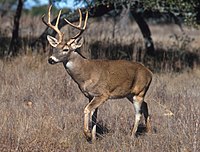
Photo from wikipedia
The intestinal microbiota has important functions that contribute to host health. The compositional dynamics of microbial communities are affected by many factors, including diet and presence of pathogens. In contrast… Click to show full abstract
The intestinal microbiota has important functions that contribute to host health. The compositional dynamics of microbial communities are affected by many factors, including diet and presence of pathogens. In contrast to humans and domestic mammals, the composition and seasonal dynamics of intestinal microbiota of wildlife species remain comparatively understudied. White-tailed deer (Odocoileus virginianus) is an ecologically and economically important wildlife species that inhabits agricultural ecosystems and is known to be a reservoir of enteric pathogens. Nevertheless, there is a lack of knowledge of white-tailed deer intestinal microbiota diversity and taxonomic composition. This study’s first objective was to characterize and compare the intestinal microbiota of 66 fecal samples from white-tailed deer collected during two sampling periods (March and June) using 16S rDNA pyrosequencing. Associations between community diversity and composition and factors including season, sex, host genetic relatedness, and spatial location were quantified. Results revealed that white-tailed deer intestinal microbiota was predominantly comprised of phyla Firmicutes and Proteobacteria, whose relative frequencies varied significantly between sampling periods. The second objective was to examine the associations between the presence of Escherichia coli and Salmonella, and microbiota composition and diversity. Results indicated that relative abundance of some microbial taxa varied when a pathogen was present. This study provides insights into microbial compositional dynamics of a wildlife species inhabiting coupled natural and agricultural landscapes. Data focus attention on the high prevalence of Proteobacteria particularly during the summer and highlight the need for future research regarding the role of white-tailed deer as a natural pathogen reservoir in agroecosystems.
Journal Title: Microbial Ecology
Year Published: 2017
Link to full text (if available)
Share on Social Media: Sign Up to like & get
recommendations!